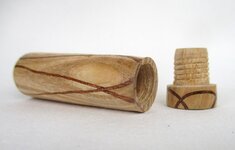You are using an out of date browser. It may not display this or other websites correctly.
You should upgrade or use an alternative browser.
You should upgrade or use an alternative browser.
Tap and die timber advice
- Thread starter Alan Morrison
- Start date
Signed-In Members Don't See This Ad
monophoto
Member
Bob Hay just did a very good series of three You-Tube videos on using metal taps and dies on wood - https://www.youtube.com/c/Woodworkingmasterclass. In this series, he's making music stands, and needs a knob to allow for height adjustment. He turns a wooden knob that incorporates a steel bolt to provide the male thread, but then uses a tap to cut female threads in the wood stand to receive that bolt..
His basic points:
I think the preferred way to thread the top of a box like this is to use a thread chaser. I've been toying with the idea of buying set for a couple of years, but I'm not convinced that I really need them enough to justify paying the $100 or so that they would cost. (call me cheap). Hand chasers are available from several manufacturers (mostly in England, curiously) and in various threadings. According to a number of YouTube videos on the subject by turners who seem to know a thing or two about threading (particularly Sam Angelo and Mike Peace), 16tpi seems to be the easiest to master.
There is another approach to making threaded tops on small containers such as these - there are a few companies (Lee Vallley comes to mind) who sell male/female thread pairs that can be fitted and glued into the container. These are typically made of brass and look pretty nice. They are pricey - $5-6 per pair. You can achieve the same effect by recycling the male/female thread pair from old disposable plastic containers.
His basic points:
- It's usually possible to use a tap to thread wood, but it's very difficult to get good male threads on a tenon with a traditional metal-cutting die. I have to agree - I've tried threading tenons with metal dies, and it just doesn't work.
- When using a metal tap to cut female threads, coarse threads almost always turn out better than fine threads.
- He recommends targeting 75% engagement. He uses a formula to calculate the required hole to receive the female threads; his formula includes a constant that he doesn't explain. I have iEngineer on my phone that suggests a hole size based only on the desired engagement; if there are constants used to calculate that hole size, they are hidden inside the app. iEngineer advises that 50% engagement should only be used in harder materials such as steel, while 75% is preferred for softer materials which includes wood. The 'Nuts and Bolts' app on my Android tablet suggests holes based on 'close' and 'free' rather than engagement percentages. Different strokes, etc.
- CA can be used to stiffen threads. The usual suggestion is to cut the threads, apply CA and let it cure thoroughly, and then run the tap back through the threads to clean up any excess CA. My experience with this is that the bit about letting the CA cure thoroughly before retapping is pretty important - cleaning CA gunk out of the threads on a metal tap isn't fun - DAMHIKT.
I think the preferred way to thread the top of a box like this is to use a thread chaser. I've been toying with the idea of buying set for a couple of years, but I'm not convinced that I really need them enough to justify paying the $100 or so that they would cost. (call me cheap). Hand chasers are available from several manufacturers (mostly in England, curiously) and in various threadings. According to a number of YouTube videos on the subject by turners who seem to know a thing or two about threading (particularly Sam Angelo and Mike Peace), 16tpi seems to be the easiest to master.
There is another approach to making threaded tops on small containers such as these - there are a few companies (Lee Vallley comes to mind) who sell male/female thread pairs that can be fitted and glued into the container. These are typically made of brass and look pretty nice. They are pricey - $5-6 per pair. You can achieve the same effect by recycling the male/female thread pair from old disposable plastic containers.
Last edited:
Alan Morrison
Member
Louie, many thanks for your reply.
I will check out the reference that you gave.
You are right that a metal cutting set won't do the job.
The internal diameter of most of my tubes are 11/32, external just over 1/2 inch, as in the photograph.
The one successful one that didnt break didnt screw that well anyway and just pushed in.
I found that it was far easier to just cut the cap with a plug to friction fit the body.
Thanks again
Alan
I will check out the reference that you gave.
You are right that a metal cutting set won't do the job.
The internal diameter of most of my tubes are 11/32, external just over 1/2 inch, as in the photograph.
The one successful one that didnt break didnt screw that well anyway and just pushed in.
I found that it was far easier to just cut the cap with a plug to friction fit the body.
Thanks again
Alan

